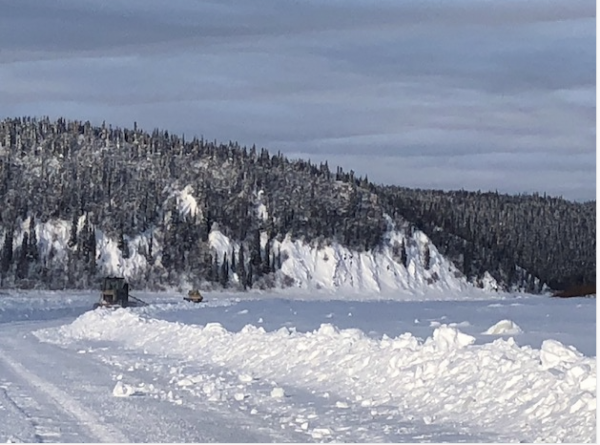
For the first time ever, the ice road on the frozen Kuskokwim River has been plowed to Sleetmute, a village north of Bethel. It’s the longest ice road yet. According to Mark Leary, who helped lead the effort, the ice road now stretches about 355 miles from Tuntutuliak, located south of Bethel, to Sleetmute.
Related: Alaska Hovercraft grades ice road between Napaskiak and Kwethluk
That’s longer than most traditional highways in the state, but it’s likely a bit rougher in places given that the road is a frozen river. The previous record was about 200 miles from Bethel to Crooked Creek in March 2018. The ice road allows for snowmachine and vehicle traffic in a region that otherwise relies on unpredictable airplane travel in the winter.
Taking care of the ice road typically begins in January. Crews cleared the river and marked the road so that travelers could make it to villages near Bethel. The average length of the ice road, according to Leary, has been about 200 miles. The farthest Leary has ever plowed has been to Crooked Creek, but this time Leary wanted to go all the way to Sleetmute.
“Our role was just to prove that it could be done. People were skeptical,” Leary said.
Cold temperatures have lingered this winter, with the average temperature in January below five degrees Fahrenheit, according to Climatologist Rick Thoman. That has kept the river frozen and made it safer for heavier vehicles to travel. Leary asked Donlin Gold, a mining company, for money to extend the ice road. Donlin Gold wants to build one of the world’s largest gold mines in the region, and contributed $20,000 as part of their community outreach.
Tim Zaukar manages the roads for the village of Crooked Creek, and helped plow the ice road to Sleetmute. He said that before the road was put in, the snow and rough ice made it hard for people to travel to other villages and to get medical aid and food supplies.
“I don’t think they really thought we would make it there, and we did, and I think a lot of people were surprised,” Zaukar said.
Related: Extreme cold temps in Bethel region mean more ice road, but river hazards remain
A crew from Napaimute, a seasonal village in the Middle Kuskokwim River area where Leary works, headed out from Bethel on Feb. 7 to plow the river, but the six-man crew hit a rough patch once they got to Chuathbaluk. Boulders of ice and thick snow blanketed the river in that section, making it impassible to snowmachine and truck traffic. He said it took a long time to bulldoze, and then plow, the stretch from Chuathbaluk to Napaimute.
“It took us 14 hours to go 20 miles. We arrived at Napaimute at 2 in the morning,” Leary said.
Once they hit Crooked Creek, where Zaukar was waiting for them, Leary said that it got a little easier.
“That’s their country. They know it,” Leary said.
Leary and Zaukar said that the ice got thinner the closer they got to Sleetmute because of the late freeze up and lots of snow insulating the ice. Close to Bethel, the ice measures 3 to 4 feet. Closer to Sleetmute, it only measured 2 feet. Zaukar and his crew helped navigate the thinner ice, and by Saturday, Feb. 15, they made it to Sleetmute.
Rebecca Wilmarth lives in Red Devil, which is about 10 miles south of Sleetmute and one of the villages that now, for the first time, has an ice road.
“It was a historical moment to extend the ice road all the way up to Sleetmute,” Wilmarth said.
The community of Sleetmute held a potluck for the two crews to thank them for their efforts.
But while the ice road is plowed, Wilmarth and Zaukar acknowledge that maintaining it will be another challenge. Red Devil doesn’t have a tribal council or city government with funds to help out.
“I’m kind of in the same boat as Tim. Not really sure what the next move is and who the responsibility will lie with at this point,” Wilmarth said.
Zaukar also said that the road will bring more traffic, which means more potential for stranded drivers. That could be a burden to search and rescue groups. But for now, residents are grateful to have a road so that they can travel to the next village or to a health clinic without flying.




